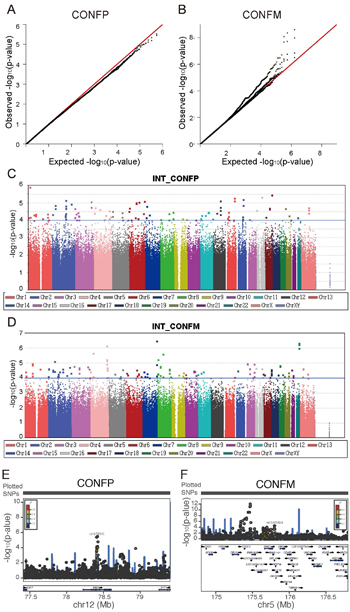检测到您当前使用浏览器版本过于老旧,会导致无法正常浏览网站;请您使用电脑里的其他浏览器如:360、QQ、搜狗浏览器的极速模式浏览,或者使用谷歌、火狐等浏览器。
 下载Firefox
下载Firefox
检测到您当前使用浏览器版本过于老旧,会导致无法正常浏览网站;请您使用电脑里的其他浏览器如:360、QQ、搜狗浏览器的极速模式浏览,或者使用谷歌、火狐等浏览器。
 下载Firefox
下载Firefox
摘要:从众乃人类社会必不可少。从众可以有益于个人、也可有益于社会。集体层面,它是卢梭社会契约论的基础、现代民主的基石;个体层面,它可用于社会学习与亲和。 但从众也有负面影响,从压制独立性、原创性,到群体歇斯底里、暴力、独裁,甚至不顾真理、公平和正义的群集行为。进化上,动物就能够从众;发育中,婴儿就出现从众。此前,从众行为在不同人显现出个体差异被认为是社会和文化等环境因素,而无遗传参与。我们用多层次的基因组分析了数千人后,证明遗传影响从众行为,发现影响从众行为的特定遗传基因,结合脑的核磁成像发现基因与脑区的相关性。
从众乃人类社会必不可少(1-5)。从众可有益于个人(通过模仿多数人的学习或得到多数人的帮助)、也可有益于社会(通过社会凝聚和稳定)。集体层面,它是卢梭社会契约论的基础、现代民主的基石(6)。个体层面,它可用于频率依赖的社会学习(7)。但是,从众也有负面影响,从压制独立性、原创性,群体歇斯底里、暴力、独裁,到不顾真理、公平和正义的群集行为(8,9)。人类个体在大多数已知错误的情况下也可能从众(10)。从众可以是信息从众(使用多数人的信息增加个体感知或行动的准确性),也可以是规范从众(与多数人亲近而增加合作或信任)。从众影响表达和感知:从众的愿望可以改变个人的感知(11)。从众可以改变已有的、强烈的、准确的记忆(12)。进化上,动物如鸟(13)、大鼠(14)、灵长类(15,16)就有从众行为;发育中,幼儿(17)甚至7个月的婴儿(18)就会从众。
从众行为在不同人有个体差异。例如,美国心理学家Asch于五十年代设计的经典线段长度判断(3),当被要求选择与标准线同样长度的线到底是多长时,被试者第一次通常能够较为准确地回答它们一样长,而在被告知多数人认为一根线短于另外一个线之后,大部分被试改变自己的回答而符合所谓“多数人”的回答,即使很明显后者是错的,少数被试则坚持自己的回答。从众的差别被认为是社会和文化等环境因素。Asch类似线判断(8)和社会偏好的研究都发现集体主义社会的居民较个体主义社会的居民更容易从众(20,21)。从众的个体差异也受早期家庭经历(22)、社会权力(23)、和主要人格特征的影响(25)。
功能性核磁共振成像(fMRI)提示参与社会从众的脑区(11,26-29),特别是后中部前皮层(pMFC),尾核,腹侧纹状体。跨颅磁刺激支持pMFC的参与,因为瞬时下调pMFC可以减少从众行为。
从众的普遍性提示从众有遗传因素,类似其他行为如帮助(31)或攻击(32)。但是,仅有一篇文章分析了从众的遗传性,其结论是从众没有任何遗传影响(33)。
在此,饶毅实验室用了两个行为方法检测从众,首次进行了对从众的多层次的基因组分析,包括:1)用1140双生子分析遗传性;2)用2130人估计全基因组范围的单核苷酸多态性(SNP)总共可以解释的遗传影响;3)用近2600人进行单基因位点的基因组关联分析(GWAS);4)基因水平的全基因组关联分析;5)通路水平的关联分析;6)64人的核磁共振成像,发现从众特异性大脑活动在不同基因型之间的差异。
这些研究证明遗传影响从众行为,发现与从众相关的特定基因(如:NAV3、PTPRD、ARL10、CTNND2)。

文章的第一作者为北大清华生命科学联合中心的研究生陈碧清和朱子建,研究由必赢bwin线路检测中心与重庆医科大学、广州眼科医院等合作,通讯作者为饶毅,共含2个图、4个表格,另有3个附图、25个附表。文章于2018年2月26日在线发表于《人类遗传学杂志》。
原文链接:https://www.nature.com/articles/s10038-018-0418-y。
PDF可见于饶毅实验室网页:http://www.raolab.org/upfile/file/20180228083255_951137_65047.pdf
部分引用文献:
1. Sherif M. The Psychology of Social Norms. New York, NY, USA: Harper & Brothers; 1936.
2. Asch SE. in Effects of group pressure upon the modification and distortion of judgements. (ed.) Guetzkow H. Groups, leadership and men. Pittsburgh, PA, USA: Carnegie Press; 1951. p. 177–190.
3. Asch SE. Studies of independence and conformity: 1. A minority of one against a unanimous majority. PsycholMonogr. 1956;70:1–70.
4. Crutchfield RS. Conformity and character. Am Psychol. 1955;10:191–8.
5. Cialdini RB, Goldstein NJ. Social influence: compliance and conformity. Annu Rev Psychol. 2004;55:591–621.
6. Grofman B, Feld SL. Rousseaus general will—a condorcetian perspective. Am PolitSci Rev. 1988;82:567–76.
7. Kendal J, Giraldeau L, Laland K. The evolution of social learning rules: payoff-biased and frequency-dependent biased transmis- sion. J Theor Biol. 2009;260:210–9.
8. Bond R, Smith PB. Culture and conformity: a meta-analysis of studies using Asch’s (1952b, 1956) Line judgment task. Psychol Bull. 1996;119:111–37.
9. Raafat RM, Chater N, Frith C. Herding in humans. Trends Cogn Sci. 2009;13:420–8.
10. Stein R. The pull of the group: conscious conflict and the invo- luntary tendency towards conformity. Conscious Cogn. 2013;22:788–94.
11. Berns GS, Chappelow J, Zink CF, Pagnoni G, Martin-Skurski ME, Richards J. Neurobiological correlates of social conformity and independence during mental rotation. Biol Psychiatry. 2005;58:245–53.
12. Edelson MG, Sharot T, Dolan RJ, Dudai Y. Following the crowd: brain substrates of long-term memory conformity. Science. 2011;333:108–11.
13. Claidiere N, Whiten A. Integrating the study of conformity and culture in humans and nonhuman animals. Psychol Bull. 2012;138:126–45.
14. Galef B, Whiskin E. ‘Conformity’ in Norway rats? AnimBehav. 2008;75:2035–9.
15. Whiten A, Horner V, de Waal FB. Conformity to cultural norms of tool use in chimpanzees. Nature. 2005;437:737–40.
16. van de Waal E, Borgeaud C, Whiten A. Potent social learning and
conformity shape a wild primate’s foraging decisions. Science.
2013;340:483–5.
17. Corriveau KH, Harris PL. Preschoolers (sometimes) defer to the
majority in making simple perceptual judgments. Dev Psychol. 2010;46:437–45.
18. Powell LJ, Spelke ES. Preverbal infants expect members of social groups to act alike. ProcNatlAcadSci USA. 2013;110: E3965–3972.
19. Kim H, Markus HR. Deviance or uniqueness, harmony or con- formity? A cultural analysis. J PersSoc Psychol. 1999;77:785–800.
20. Triandis HC. in Cross-cultural studies of individualism and col- lectivism. (ed.) Berman JJ. Nebraska symposium on motivation. Lincoln, NE, USA: University of Nebraska Press; 1989. p. 41–133.
21. Takano Y, Sogon S. Are Japanese more collectivistic than Americans? Examining conformity in in-groups and the reference- group effect. J Cross Cult Psychol. 2008;39:237–50.
22. Kasser T, Koestner R, Lekes N. Early family experiences and adult values: a 26-year, prospective longitudinal study. PersSocPsychol Bull. 2002;28:826–35.
23. Wright DB, London K, Waechter M. Social anxiety moderates memory conformity in adolescents. ApplCogn Psychol. 2010;24:1034–45.
24. Galinsky AD, Magee JC, Gruenfeld DH, Whitson JA, Liljenquist KA. Power reduces the press of the situation: implications for creativity, conformity, and dissonance. J PersSoc Psychol. 2008;95:1450–66.
25. de Young CG, Peterson JB, Higgins DM. Higher-order factors of the Big Five predict conformity: are there neuroses of health? PersIndiv Differ. 2002;33:533–52.
26. Klucharev V, Hytonen K, Rijpkema M, Smidts A, Fernandez G. Reinforcement learning signal predicts social conformity. Neuron. 2009;61:140–51.
27. Campbell-Meiklejohn DK, Bach DR, Roepstorff A, Dolan RJ, Frith CD. How the opinion of others affects our valuation of objects. Curr Biol. 2010;20:1165–70.
28. Izuma K, Adolphs R. Social manipulation of preference in the human brain. Neuron. 2013;78:563–73.
29. Stallen M, Smidts A, Sanfey AG. Peer influence: neural mechanisms underlying in-group conformity. Front Hum Neu- rosci. 2013;7:1–7.
30. Klucharev V, Munneke MAM, Smidts A, Fernandez G. Down regulation of the posterior medial frontal cortex prevents social conformity. J Neurosci. 2011;31:11934–40.
31. Constantino JN, Todd RD. Genetic structure of reciprocal social behavior. Am J Psychiatry. 2000;157:2043–5.
32. Rushton JP, Fulker DW, Neale MC, Nias DKB, Eysenck HJ. Altuism and aggression: the heritability of individual differences. J PersSoc Psychol. 1986;50:1192–8.
33. Li XT, Zhang JD, Huang Y, Xu M, Liu J. Nurtured to follow the crowd: a twin study on conformity. Chin Sci Bull. 2013;58:1175–80.